Archived Storm Damage Blog Posts
Hurricane Preparedness Month: Essential Tips and Professional Cleanup Services for Property Owners in Point Pleasant
9/13/2024 (Permalink)
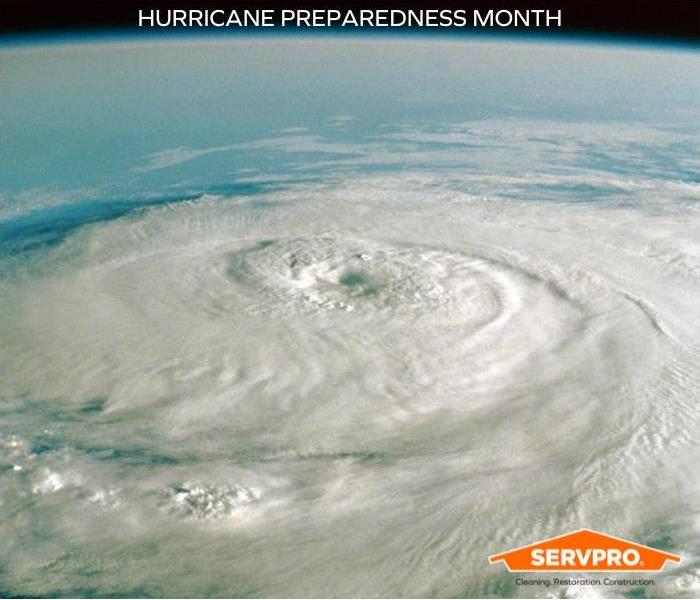 Hurricane Preparedness Month emphasizes the importance of planning, securing your home, and assembling emergency supplies to stay safe.
Hurricane Preparedness Month emphasizes the importance of planning, securing your home, and assembling emergency supplies to stay safe.
As Hurricane Preparedness Month rolls around, it's the perfect time to focus on getting ready for the storms that could impact NJ residents in the coming months. Taking the time to plan and prepare can make all the difference so let’s cover essential tips for preparing your home and family.
Why Hurricane Preparedness Matters
Hurricanes can cause devastating damage, from flooding and high winds to power outages and property destruction. Proper preparation can significantly reduce the impact on your home and ensure the safety of your loved ones. Here’s how you can get ready:
- Create an Emergency Plan: Develop a comprehensive plan that includes evacuation routes, emergency contacts, and a communication strategy. Make sure every family member is aware of the plan and knows what to do in different scenarios.
- Assemble an Emergency Kit: Stock up on essential supplies such as water, non-perishable food, medications, first aid supplies, flashlights, batteries, and a battery-operated radio. Don’t forget important documents and personal items.
- Secure Your Home: Reinforce windows and doors, check your roof for damage, and consider installing storm shutters. Clear gutters and downspouts to prevent water buildup and reduce the risk of flooding.
- Stay Informed: Keep up with weather forecasts and warnings through reliable sources. Sign up for local alerts and have a battery-powered or hand-crank weather radio handy to receive updates even if the power goes out.
- Review Insurance Policies: Ensure your homeowners or renters insurance covers hurricane damage, including flood insurance if necessary. Understanding your coverage can help you manage claims and repairs more effectively after a storm.
The Role of Professional Hurricane Cleanup and Restoration Services from SERVPRO of Point Pleasant
Even with thorough preparation, hurricanes can still cause significant damage that requires professional intervention. Here’s why enlisting the help of professionals is crucial:
- Expert Assessment and Damage Control: SERVPRO of Point Pleasant technicians have the expertise to assess the extent of damage and address issues such as water damage, structural issues, and mold growth effectively. Our experience helps in prioritizing repairs and preventing further damage.
- Specialized Equipment and Techniques: Our professionals use advanced equipment and techniques for water extraction, drying, and dehumidification. This helps to address the damage more efficiently and reduces the risk of long-term problems.
- Fast and Efficient Restoration: Time is of the essence when dealing with hurricane damage. Our technicians will act quickly to mitigate damage, perform repairs, and restore your home to its pre-storm condition, allowing you to get back to normalcy faster.
- Insurance Assistance: We can work directly with insurance companies to streamline the claims process and can provide detailed documentation and assist in managing paperwork, making the recovery process less stressful.
- Health and Safety Considerations: Post-storm environments can pose health risks, including mold growth and hazardous debris. Our professionals are trained to handle these situations safely, ensuring that your home is not only repaired but also safe for reoccupation.
Hurricane Preparedness Month is an opportunity to take proactive steps in safeguarding your home and family. By preparing ahead of time and understanding the value of professional cleanup and restoration services, you can significantly reduce the impact of hurricanes and ensure a smoother recovery process.
Remember, preparation isn’t just about stocking up supplies—it’s about creating a comprehensive plan, protecting your home, and knowing when to call in the experts at SERVPRO of Point Pleasant. For more information on professional hurricane cleanup and restoration services, call us today at 732-202-3001.
What is the Transition from Thunderstorm to Hurricane?
4/26/2023 (Permalink)
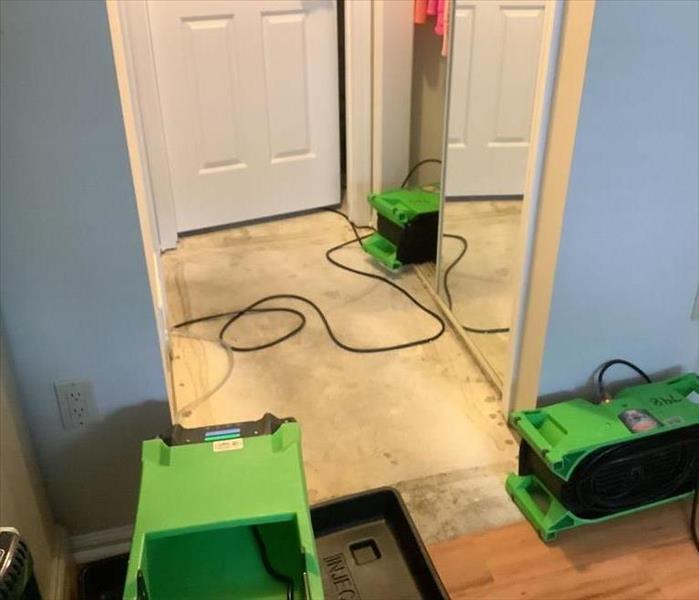 We’re dedicated to responding immediately to storm damage emergencies because A fast response helps lessens the damage and reduces cost.
We’re dedicated to responding immediately to storm damage emergencies because A fast response helps lessens the damage and reduces cost.
About 25 to 30 thunderstorms happen per year in New Jersey and in Point Pleasant. There is roughly 11 significant two day storms that happened per year. While hurricanes normally occur once every ten years. Although that is not often, all it takes is a thunderstorm, warm ocean
water and light winds for a hurricane to form. It is important to understand the difference in order
to protect yourself, your family, and prepare properly. SciJinks accurately breaks down the four transition stages from thunderstorm to hurricane below:
- Tropical Disturbance: Once water vapor from the warm ocean condenses to form
clouds, it releases heat into the air. The warm air then rises and is pulled into the column of clouds. A pattern starts to develop with wind circulating around the center and as it encounters more clouds it is called a tropical disturbance. - Tropical Depression: The air at the top of the cloud column starts cooling and becoming unstable as the thunderstorm grows higher and larger. As the heat energy is released from the cooling water vapor, the air at the top of the clouds become warmer, making air pressure higher causing winds to move outward. The movement and warming causes pressures at the surface to drop. When winds reach between 25 and 38mph the storm is called a tropical depression.
- Tropical Storm: Winds have to reach 39mph for the tropical depression to become a tropical storm. The storm will get a name, winds blow faster and start twisting around the eye.
- Hurricane: Once wind speed reaches 74mph it is considered a hurricane. The storm is at least 50,000 feet high, reaches 125 miles across and the eye is between 5 to 30 miles wide.
Hurricanes Categories:
- Category 1: Winds 74 to 95 mph (Minimal damage)
- Category 2: Winds 96 to 110 mph (Moderate damage)
- Category 3: Winds 111 to 129 mph (Extensive damage)
- Category 4: Winds 130 to 156 mph (Extreme damage)
- Category 5: Winds 157 mph or higher (Catastrophic damage)
Experiencing a storm can be an unsettling thing, and it is even worse if your home or business
has been affected. If you find yourself in that situation, we are here to help. Call SERVPRO of
Point Pleasant for all your storm damage repair
needs 732-202-3001.
Day Four of Hurricane Preparedness Week: Flood Insurance
5/4/2022 (Permalink)
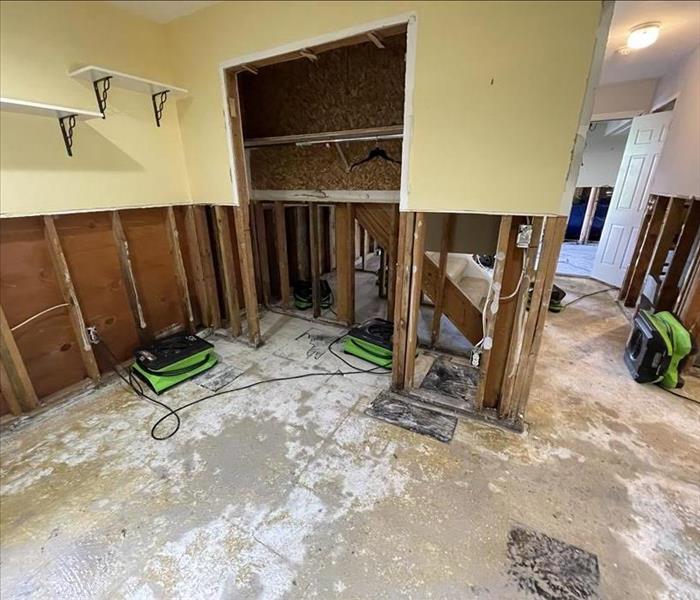 SERVPRO of Point Pleasant uses advanced equipment and scientific drying techniques after storm damage or flood damage.
SERVPRO of Point Pleasant uses advanced equipment and scientific drying techniques after storm damage or flood damage.
Being prepared with flood insurance can help you rebuild your home faster and stronger. No home is completely safe from the risk of potential flooding. Floods can happen anywhere and just one inch of floodwater can cause up to $25,000 in damage, according to FEMA If you’re not protected, you could be responsible for paying for costly damage all on your own.
Need Flood Insurance?
Call your insurance company or insurance agent, or ask a friend or family member who they use or contact The National Flood Insurance Program (NFIP) to get a quote as soon as possible. Plan ahead as there is typically a 30-day waiting period for an NFIP policy to go into effect.
Currently Have Flood Insurance?
Do an insurance check-up: make sure you have enough insurance to repair or even replace your home and/or belongings. Remember, home and renters insurance doesn’t cover flooding, so you’ll need a separate policy for it.
Flooding can be an emotionally and financially devastating event. With flood insurance, you're able to recover faster and more fully.
Have Storm or Flood Damage?
Major storms and flooding events can overwhelm many restoration companies. On the other hand, SERVPRO of Point Pleasant has helped many people in the aftermath of hurricanes and flooding, including Superstorm Sandy. We are storm and flooding damage specialists who get started promptly to get your property dry and back to pre-flood and pre-storm condition.
Day Three of Hurricane Preparedness Week: Emergency Disaster Kit
5/3/2022 (Permalink)
 Be hurricane ready!
Be hurricane ready!
When preparing for hurricanes, having supplies to make it through the hurricane isn’t enough. Ensure you have supplies for the recovery period, which could be very long depending on the damage. In some cases, water, electricity and gas could be out for a day or even over a week. You may need to survive on your own for several days so having an emergency hurricane disaster kit in the event of a hurricane could be a life saver.
What is an Emergency Hurricane Disaster Kit?
An emergency hurricane disaster supply kit is a collection of basic items your household may need in the event of an emergency.
What Items Should Be in the Hurricane Emergency Disaster Kit?
- Cash-banks and ATMs may not be open or available for extended periods.
- Water-at least one gallon per person per day for three to seven days, plus water for pets.
- Food-at least enough for three to seven days, including: Non-perishable packaged or canned food and juices, food for infants and the elderly, snack food, paper plates, plastic utensils.
- Manual can opener (non-electric)
- Radio-battery powered and NOAA weather radio with extra batteries.
- Blankets, pillows etc.
- Clothing-seasonal, rain gear/ sturdy shoes.
- First Aid Kit-plus medicines, prescription drugs, vitamins
- Special items-for babies and the elderly.
- Toiletries-hygiene items, moisture wipes, sanitizer.
- Flashlight and batteries.
- Keys
- A portable crank or solar-powered USB charger for your cell phones.
- Toys, books and games.
- Pet care items, proper identification, immunization records, ample food and water, medicine, a carrier or cage, leash.
Once you take a look at the basic items consider what unique needs your family might have, according to Federal Alliance for Safer Homes.
How Much of Each Should Be in Your Emergency hurricane Disaster Kit?
Have enough non-perishable food, water and medicine to last each person in your family a minimum of 3 days (store a longer than 3-day supply of water, if possible) to ensure your family's basic comfort and well-being.
How Should These Items be Safely Stored?
To assemble your kit store items in airtight plastic bags and put your entire disaster supplies kit in one or two easy-to-carry containers such as plastic bins or a duffel bag.
Where Should Your Emergency Hurricane Disaster Kit Be Kept?
This kit should be kept at home in a designated place and should be have it ready in case you have to leave your home quickly. Make sure all family members know where the kit is kept.
What Should You Do to Keep the Supplies Updated?
Remember to replace stored food and water every six months, keep a supply of fresh batteries on hand. Re-think your needs every year and update your kit as your family’s needs change.
Day Two of Hurricane Preparedness Week: Evacuation
5/2/2022 (Permalink)
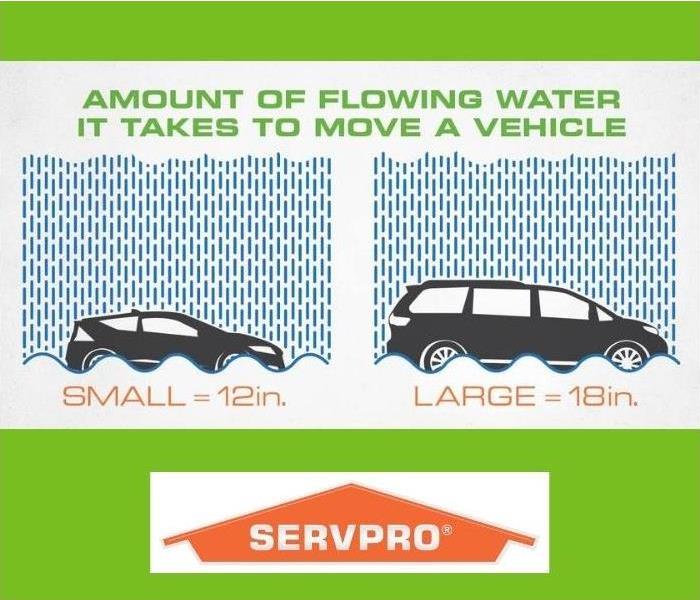 Two feet of rushing water can carry away most vehicles, including SUVs and pickups.
Two feet of rushing water can carry away most vehicles, including SUVs and pickups.
Day Two Hurricane Preparedness Week: Evacuation Plan
If you live in a hurricane evacuation zone or your area is prone to flooding you may need to leave your home. Also, if you reside in a mobile home and near an evacuation zone you may also need to leave your home. Now is the time to begin planning where you would go and how you would get there.
As hurricane season approaches, listen to local officials on questions related to how you may need to adjust any evacuation plans your local officials.
Do You Know New Jersey’s Coastal Evacuation Routes?
They show the various state roads that have been identified as potential evacuation routes for coastal emergencies in Ocean County such as approaching Tropical Storms or Hurricanes. You can prepare for an evacuation by using a local map to identify the roads you would take to reach these Evacuation Routes from home, work or any place where you and your family spend time.
Remember that all evacuation plans, including the evacuation routes posted are flexible and may change based on the nature of an emergency.
When local, county or State officials order you to evacuate, they will provide specific information about the roads you should take. Police and first responders will be posted in your community to direct traffic and block roads that are unsafe. Click here to find the Ocean County and surrounding coastal evacuation maps from the State of New Jersey Office of Emergency Management.
What Should You Do If Your Evacuation Route Gets Flooded?
Always avoid driving into flooded areas! Remember to “Turn Around, Don’t Drown” is the motto of NJ.gov in the event of bad weather and flooding.
A flash flood occurs within a few hours (usually less than 6 hours) of heavy or excessive rainfall, a dam or levee failure, or the sudden release of water. Flash flood warnings and area-based flood warnings are issued as tropical systems make landfall. Many flash flood fatalities occur at night.
A flood develops more slowly, normally taking more than 6 hours. Area-based flood warnings may continue for days or weeks until flood waters have receded.
Water is very powerful. Six inches of fast-moving water can knock you off your feet. Two feet of rushing water can carry away most vehicles, including SUVs and pickups. Most flooding deaths occur in automobiles.
Day One of Hurricane Preparedness Week: Risk Assessment
5/1/2022 (Permalink)
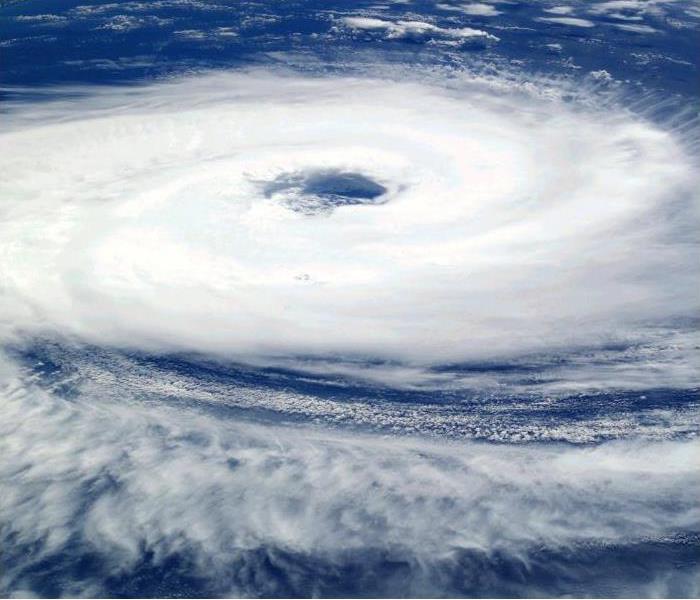 Determining your risk is the first part of Hurricane Preparedness Month!
Determining your risk is the first part of Hurricane Preparedness Month!
To kick off Hurricane Preparedness Week, the first part of preparation is determining your risk. Everyone lives in an area with some flood risk, it’s just a question of whether you live in a high-risk, low-risk, or moderate-risk flood area.
Do You Know Where to Track a Hurricane?
Learn about your flood zone and know your risk. The NOAA can help you with its Historical Hurricane Tracks Tool that uses your zip code to display paths of past storms related to your location.
Can You Predict Your Chance of Flooding Due to a Hurricane?
Using flood maps can show you your community’s risk of flooding. Specifically, flood maps show a community’s flood zone, floodplain boundaries, and base flood elevation.
What Are Flood Maps?
Flood maps show a community’s risk of flooding. Specifically, flood maps show a community’s flood zone, floodplain boundaries, and base flood elevation.
Where Can You Find Your Flood Map?
You can find your flood map on the FEMA Flood Map Service Center.
Can Your Flood Risk Change?
How water flows and drains can change due to new construction and community development or natural forces such as changing weather patterns or terrain changes. Also, communities may build levees and dams, decreasing flood risk over time. Although the frequency or severity of impacts cannot be changed, FEMA is working with federal, state, tribal and local partners across the nation to identify flood risk and promote informed planning and development practices to help reduce that risk through the Risk Mapping, Assessment and Planning (Risk MAP) program. To better reflect your current flood risk, the National Flood Insurance Program and the Federal Emergency Management Agency use the latest technology and data to update flood maps nationwide.
April Showers Bring May Flowers or... Property Damage in Ocean County
4/20/2022 (Permalink)
It's finally Spring! The daylight begins to stay out longer, the days begin to warm up a little, but then you remember it's still April. April gives us lots of wet weather here in Ocean County. Yesterday was a perfect example. People were outside enjoying the 80 degree day when all of a sudden the sky darkened and the storms rolled in. Wind gusts picked up and there was a sprinkling of lightening in there too.
Thunderstorms are common this time of year in New Jersey, especially in the afternoon and evening hours in the and can produce very dangerous lightning. Follow these safety tips from the American Red Cross to stay safe if a storm rolls in:
Where there is thunder, there is lightning! If thunder can be heard, then you are close enough to be in danger of lightning strikes. Go indoors!
Postpone any outdoor activities, such as sporting events and picnics until the storm passes. It is possible to get struck by lightning even if it is not raining.
Take shelter in a building or vehicle with windows closed and stay clear of the windows.
We can follow these tips to stay safe but unfortunately, there is no foolproof way to completely protect your house from lightning damage, wind damage and storm damage. Following a storm, in order to prevent further damage, it is always important to look for signs of roof damage. Some things to look for are holes, missing or dented shingles, and dented or cracked gutters and downspouts.
SERVPRO of Point Pleasant responds immediately, any time, day or night to a storm damage emergency. A quick response is crucial to help limit the additional interior damage and understand the importance of responding quickly to help prevent secondary damage and reduce restoration costs. Our team can provide temporary protective measures to prevent additional damage to the property after a storm including board ups, temporary fencing and portable power.
Hopefully the storms will end at the end of the month and May will bring flowers to New Jersey instead of property damage!
SERVPRO of Point Pleasant Offers Emergency Storm & Flood Damage Cleanup
4/15/2022 (Permalink)
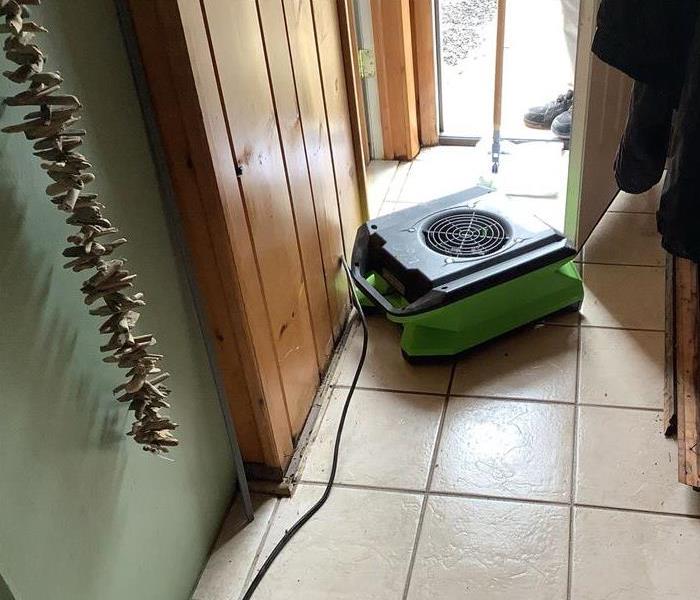 There are 3,277 properties in Point Pleasant that have greater than a 26% chance of being severely affected by flooding.
There are 3,277 properties in Point Pleasant that have greater than a 26% chance of being severely affected by flooding.
Living at the Jersey Shore, flooding is something a lot of us are familiar with. There are two types of flooding that are the most common in Ocean County are flash floods and coastal floods. Below is a brief description of each:
Flash floods are a sudden local flood, typically due to heavy rain. They can also be caused by dam or levee breaks, or mudslides (debris flow). The intensity of the rainfall, the location and distribution of the rainfall, the land use and topography, vegetation types and growth/density, soil type, and soil water-content all determine just how quickly the Flash Flooding may occur, and influence where it may occur. If people are at their homes or businesses, the water may rise quickly and trap them, or cause damage to the property without them having a chance to protect the property, according to the National Weather Service. Flash Flooding is possible everywhere. The normally tranquil streams and creeks in your neighborhood or area can become raging torrents if heavy rain falls overhead.
Coastal floods are when the coast is flooded by the sea. It occurs when low-lying land is flooded by seawater. According to Washington Coastal Hazards Resilience Network, common causes of coastal flooding are:
- Storm surge-changes in atmospheric pressure can elevate seawater levels during a storm, pushing more water toward the shore.
- Wind-driven waves-wind can push water higher and further onto land, causing coastal flooding.
- High tides and king tides-high tides can combine with other factors to cause coastal flooding. King tides are exceptionally high tides caused by one or more astronomical events happening at the same time.
- Sea level rise – as daily tides become higher smaller magnitudes of storm surge, wind and other factors will result in coastal flooding.
- Increased river flows – increased river discharge, caused by changes in rainfall, groundwater storage, and melting snowpack, can combine with seawater levels to flood coastal areas.
Severe weather from hurricanes, thunderstorms, and floods can cause significant damage to your Point Pleasant property. Water can be extremely destructive and the longer it remains, the more damage it could cause to your property.
When it comes to storms and floods, few people anticipate that it will actually cause damage to their home, whether it be water damage from either storm or a flood, SERVPRO of Point Pleasant provides emergency water damage cleanup restoration services. We are available 24 hours a day, 7 days a week, 365 days a year, including holidays.
The Blizzard of 2022
2/22/2022 (Permalink)
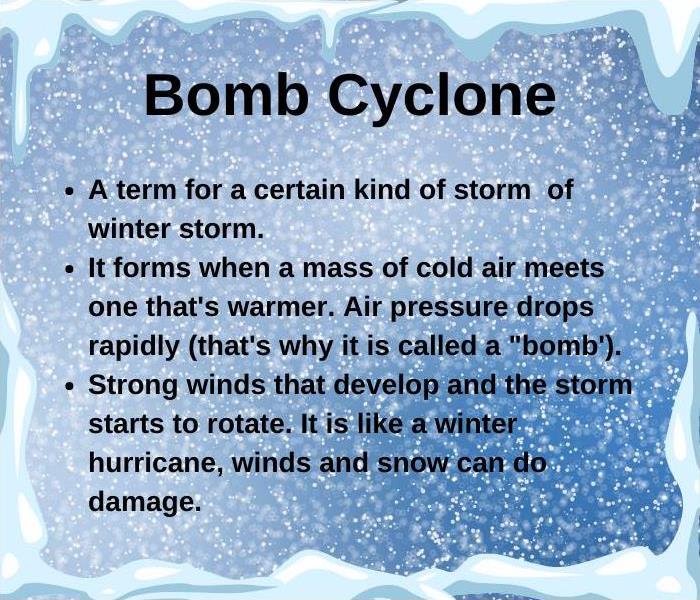 What is a bomb cyclone?
What is a bomb cyclone?
The Blizzard of 2022!
Ocean County, along with the Eastern Coast of Ney Jersey, was expecting a severe winter storm to hit here the last weekend in January. The storm started late on Friday night and by Saturday morning the nor'easter brought lots of gusting winds that were blowing sideways. Some areas had wind gusts of 70 mile per hour. Bands of snow and wind clobbered the Jersey Shore throughout the day. Drifting snow from the wind made snow totals hard to measure.
When is a snow storm considered a blizzard?
A blizzard is defined as three or more hours of visibility reductions to one quarter mile or less due to falling or blowing snow, and sustained winds or frequent gusts of 35 mph or greater. The National Weather Service confirmed Blizzard Conditions along the entire coastal strip of New Jersey from Cape May to Sandy Hook, NJ during the Nor’easter of January 28 and 29, 2022.
Saturday morning, the air pressure dropped and the storm rapidly turning into a bomb cyclone.
What is a bomb cyclone?
A "bomb cyclone" is a term given to a rapidly strengthening storm that fulfills one important criterion. Generally, pressure must drop 24 millibars (a unit of pressure) within 24 hours. However, that benchmark is also based on the latitude of the storm. So, the millibar requirement can change depending on where the storm forms, according to CNN.
Have storm damage in your Brick or Point Pleasant business or home?
Let SERVPRO of Point Pleasant handle all of your storm damage cleanup. We are your local water damage specialists who get started promptly to get your property dry and back to pre-storm condition. Using advanced equipment and scientific drying techniques, we document the drying process to validate your home or business is ready.
Winter Weather Heading to Ocean County on January 28, 2022
1/27/2022 (Permalink)
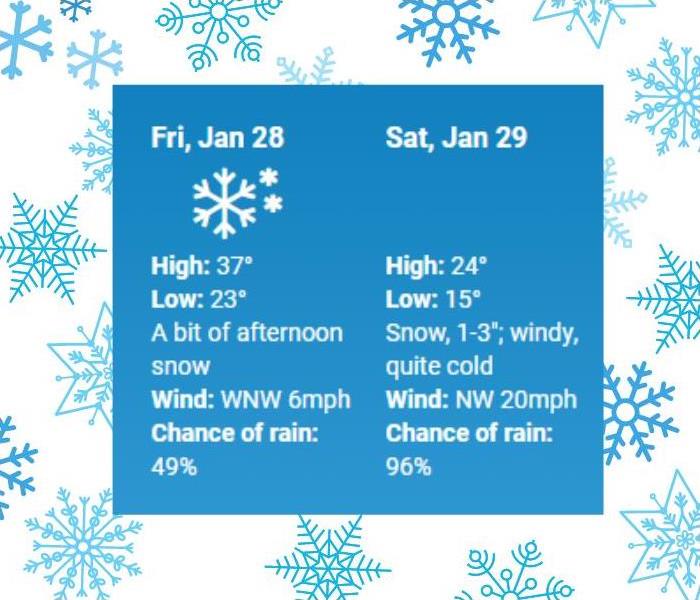 Be aware of the wind chill. Dress appropriately and avoid staying in the cold too long. Stay safe!
Be aware of the wind chill. Dress appropriately and avoid staying in the cold too long. Stay safe!
Winter Storm Watch
Start Friday, January 28, 7:00 PM EST
End Saturday, January 29, 7:00 PM EST
WINTER STORM WATCH IN EFFECT FROM FRIDAY EVENING THROUGH SATURDAY EVENING...
Heavy snow possible. Total snow accumulations of 6 to 12 inches possible. Winds could gust as high as 45 mph.
The coastal counties of New Jersey including Point Pleasant, Bricktown, and surrounding towns according to AccuWeather.
IMPACTS Travel could be very difficult to impossible.
ADDITIONAL DETAILS Snow is expected to begin Friday evening in Delmarva and southern New Jersey, spreading northward overnight into Saturday morning. Snow may be heavy at times through mid afternoon before diminishing Saturday evening. Strong winds may generate blowing snow and very low visibilities at times. The storm total snow forecast remains very uncertain, so stay tuned to the latest forecasts.
PRECAUTIONARY/PREPAREDNESS ACTIONS
Flooding Information for Your Home or Business
9/17/2021 (Permalink)
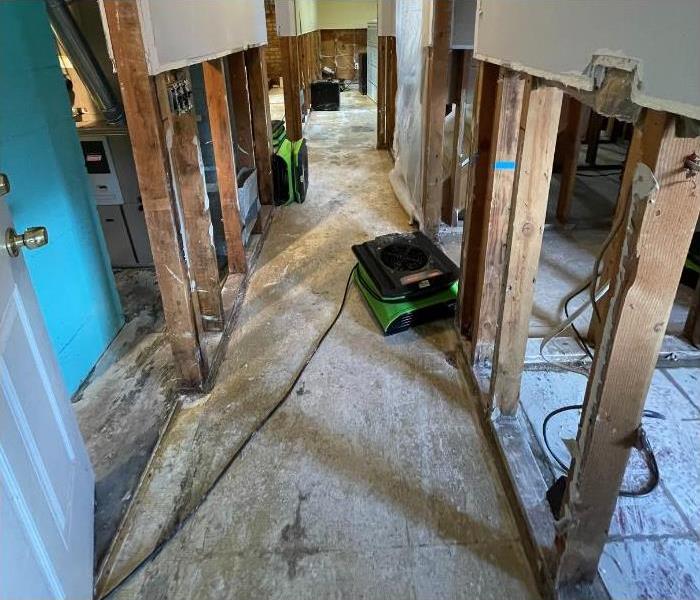 SERVPRO of Point Pleasant understands that every flood damage is different and requires a unique solution. Call us today at 732-202-3001.
SERVPRO of Point Pleasant understands that every flood damage is different and requires a unique solution. Call us today at 732-202-3001.
What is flooding?
Flooding is a temporary overflow of water onto land that is normally dry.
What could cause flooding?
- Result from rain, snow, coastal storms, storm surges and overflows of dams and other water systems.
- Develop slowly or quickly. Flash floods can come with no warning.
- Cause outages, disrupt transportation, damage buildings and create landslides.
What you should know about Flood Safety:
- Make a family emergency communication plan and include pets.
- Have emergency supplies in place at home, at work, and in the car.
- Check on your neighbors to make sure they’re okay.
- Know what to do before, during, and after a flood.
- Flood insurance takes 30 days to take effect.
- Listen to local officials by radio, TV or social media.
- Evacuate when advised by authorities or if you are in a flood or flash flood prone area.
- If you are on high ground above flooded areas, being prepared to stay where you are may be the best protection.
- Never drive or walk through flooded streets.
For FEMA's Be Prepared for a Flood information sheets, click here.
When can you return to your home after a flood?
Pay attention to authorities for information and instructions than return home only when authorities say it is safe.
What can you do to restore your home or business after a flood?
Call SERVPRO of Point Pleasant as soon as possible. has the specialized training and expertise to restore your home back to its pre-storm condition. Our restoration process puts an emphasis on scientific drying techniques, progress monitoring and documentation. Our quick response will help prevent secondary damage and help reduce restoration costs.
Tropical Depression Henri dumps more than 8 inches of rain on parts of NJ.
8/30/2021 (Permalink)
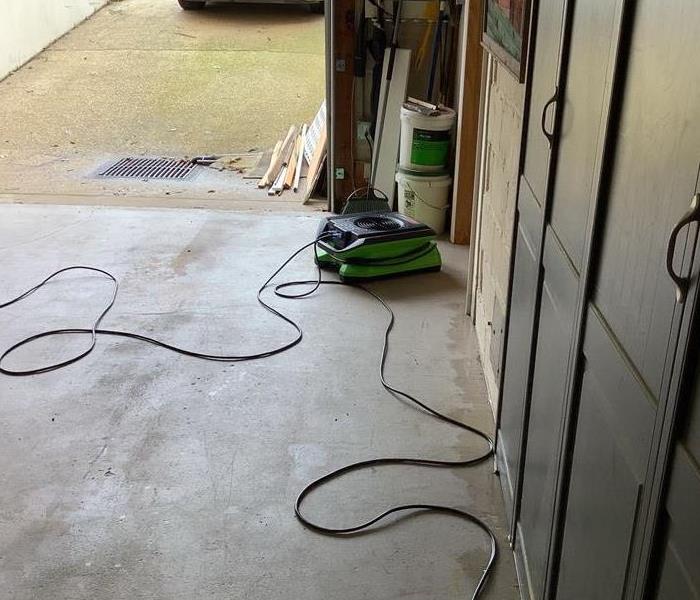 When a storm hits your home or business, you need help immediately. Our quick response will help return to normal quickly.
When a storm hits your home or business, you need help immediately. Our quick response will help return to normal quickly.
Though Hurricane Henri was expected to avoid a direct hit on New Jersey, the National Weather Service was forecasting it would bring heavy rain, strong winds, and flash flooding, with the northern half of the state at the most risk for the torrential weather. Henri was upgraded from a tropical storm to a hurricane late Saturday morning. Rain and wind in New Jersey were expected to begin sometime Saturday night. Luckily, the storm was downgraded to a tropical depression before and Ocean County did not get a direct hit. We did experience heavy rainfall, with Brick receiving about 2.65 inches, Manchester 2.1 inches and Jackson 2.27 inches. Some other areas in New Jersey received more than 8 inches, according to NJ.com.
Do you know the difference between a tropical storm and tropical depression?
A tropical depression is a tropical cyclone that has maximum sustained surface winds (one-minute average) of 38 mph (33 knots) or less. A tropical storm is a tropical cyclone that has maximum sustained surface winds ranging from 39-73 mph (34 to 63 knots), according to the National Weather Service.
New Jersey was under a tropical storm watch because the path for Tropical Storm Henri was uncertain until it got closer to New Jersey. As the path became certain, Ocean County was going to avoid a direct hit and the storm’s intensity decreased. We were just going to get the outer bands from the storm which means rain, rain and more rain with a chance of flooding.
Do you know the difference between a tropical storm watch and a tropical storm warning?
A tropical storm watch is issued when Tropical Storm conditions, including winds of 39-73 mph, pose a POSSIBLE threat to a specified coastal area within 48 hours. A tropical storm warning is issued when Tropical Storm conditions, including winds of 39-73 mph, are EXPECTED in a specified coastal area within 36 hours or less.
If your property experienced storm damage for the storm, call SERVPRO of Point Pleasant to quickly and properly restore your structure. We have specialized training and expertise to restore your home back to its pre-storm condition. Our restoration process puts an emphasis on scientific drying techniques, progress monitoring and documentation.
Could NJ be looking at more rainfall and more flooding this week due to Hurricane Ida heading to NJ?
8/30/2021 (Permalink)
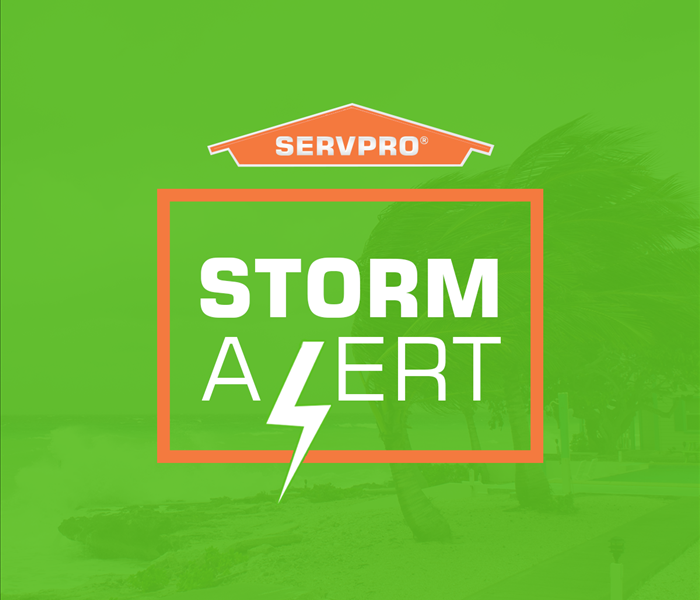 A fast response to flooding is a critical part of limiting the damage and getting your life back to normal.
A fast response to flooding is a critical part of limiting the damage and getting your life back to normal.
As Hurricane Ida makes a right turn and heads towards NJ, it is expected to be downgraded from a category 4 hurricane but it could still bring lots of rain and flooding to Ocean County when it arrives. After an already wet summer from lots of storms including Tropical Storm Fred and then Tropical Storm Henri, Ida is predicted over the next few days to weaken into a tropical depression when it arrives in NJ. The center (or eye) of the storm appears to be heading right towards NJ. Forecasters are predicting the 200 mile wide storm to arrive in NJ sometime on Wednesday or Thursday depending on her speed and if her paths shifts a bit. Ida may bring up to 4-6 inches of rainfall to the Garden State this week.
Hurricane Ida is probably going to bring more rain and cause more flooding problems. Significant flash flooding may become a concern starting Wednesday due to the heavy rain and flooding that was brought to us last week when Tropical Storm Henri came through. A Flash Flood Watch has already been issued for most of New Jersey, from Wednesday morning through Thursday evening. The weather service said flooding is possible in creeks, streams and areas with poor drainage. Water is expected to cover roads, particularly in low lying areas.
SERVPRO of Point Pleasant has the Resources to Handle Major Storms and Disasters
We are locally owned and operated, so we can respond immediately with our highly trained technicians. You can trust our professionals to handle your damages with care, precision, and expert knowledge.
Have Storm or Flood Damage? Call SERVPRO of Point Pleasant today at 732-349-9898.
Want to Be Severe Storm Ready?
7/28/2021 (Permalink)
 Simple measures prepared before the storm can save you hours of aggravation after the storm.
Simple measures prepared before the storm can save you hours of aggravation after the storm.
Some dangers of severe weather and storms include tornadoes, strong winds, hail and flash flooding. There is not always time to get everything we may need together quickly before the storm, so always have stuff ready for quick evacuation. Some items you may want to have packed and ready include:
- non-perishable food
- manual can opener
- water
- battery powered radio
- flashlight
- lanterns
- extra batteries
- personal hygiene items
- medications
- first aid supplies/kit
- copies of important documents
- cell phone fully charged
- important contact information for family and friends
- blankets
- change of clothes
- pocket knife
- rain gear
- cash
What should my first aid/medical kit contain?
- sterile adhesive bandages
- antiseptic
- tape
- compresses
- pain relievers
- scissors
- tweezers
- first aid guide
- moist towelettes
What important documents should I copy and have ready?
- insurance cards
- medical records
- bank numbers
- credit card numbers
- copies of birth certificates and/or marriage licenses
- copy of social security cards
- other personal documents
- copy of wills
- titles of cars and properties
- house inventory photos
Never leave your pets behind and make sure you have enough extra food, water, leashes, medicines and vet records for them.
We all hope to never need to use these emergency kits but it is always better to be prepared just in case an emergency strikes.
Strong Storms Bring Power Outages and Flooding to Ocean County
7/19/2021 (Permalink)
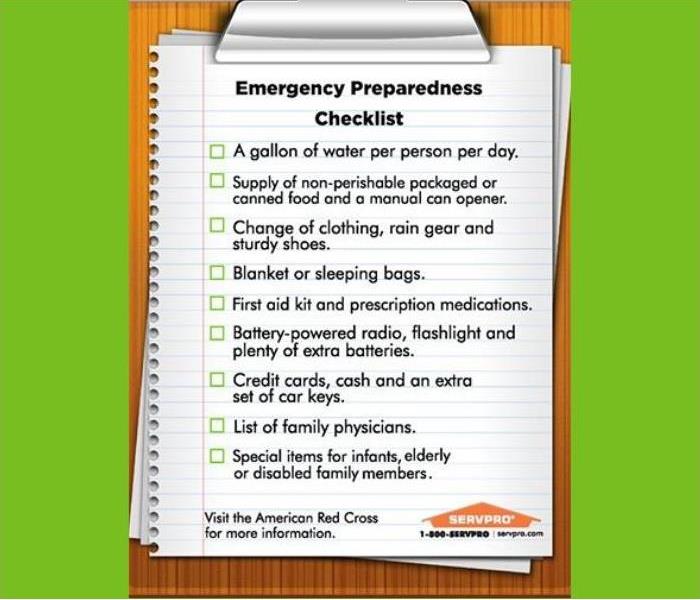 Follow these easy 9 steps to be prepared for future storms in NJ.
Follow these easy 9 steps to be prepared for future storms in NJ.
Ocean County and surrounding areas have woken up to scattered debris and some damage after strong thunder and lightning storms blew through these last few weeks. Howling winds brought down trees and branches and caused power outages across Ocean County.
Monday’s storm on July 12, 2021 tore through our area. Hooper Avenue near Oak Avenue in Toms River had downed power lines and there were nearly 2,000 homes without power as of 5 p.m. The storm brought down power lines in some places, and there were reports of homes possibly struck by lightning, according to the The Patch.
Tropical storm Elsa headed to the Jersey Shore this past Friday, July 9, 2021, with heavy rain, severe winds, heavy rain and flash flooding. This storm brought traffic disruptions at three Toms River intersections.
Powerful thunderstorms pushed through Ocean County on Tuesday night, July 6, 2021. The storm caused more than 3,500 Ocean County homes and businesses to still be without power on Wednesday morning. According to National Weather Service Mount Holly, the storm was very active, with nearly 900 cloud-to-ground lightning strikes recorded in Central Jersey in an hour
With NJ not even half way through the hurricane season that lasts from June 1st to November 30th, we have already seen some serious storms already. New Jersey's tropical storm activity is typically between August and late October, according to Office of Emergency Management. Weather researchers from Colorado State University say the 2021 Atlantic hurricane season will likely be more active than normal, for the sixth straight year. But they don’t expect it to be as stormy as last year’s explosive, record breaking season. CSU is predicting 17 named storms, five higher than the normal average. Of the 17, eight are likely to intensify into hurricanes, and four of those are likely to become major hurricanes. Major hurricanes are storms that are classified as Category 3, 4 or 5 in terms of wind strength. Category 3 hurricanes pack sustained winds of 111 to 129 mph, Category 4 storms produce winds as strong as 130 to 156 mph and Category 5 hurricanes generate catastrophic winds higher than 156 mph.
Follow SERVPRO's Emergency Preparedness Checklist to be storm ready.
What is the Next Step After Flooding in your Point Pleasant Home?
10/18/2020 (Permalink)
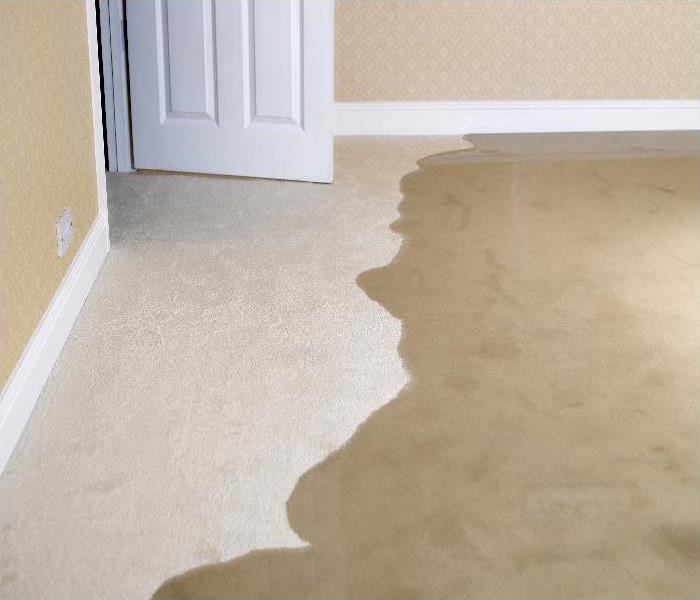 Cabinet drying typically takes longer but is essential to recovering your home from flood losses.
Cabinet drying typically takes longer but is essential to recovering your home from flood losses.
SERVPRO Can Dry Cabinets and Cavities in your Point Pleasant Home after Flood Damage.
Do wet cabinets dry naturally?
Floodwaters can enter and spread throughout your Point Pleasant Beach property leading to wet walls behind cabinets and fittings. These areas are particularly challenging to dry because of space limitations and the multiple layers of cabinet backs and drywall. The low ventilation level typically means fittings dry slowly without intervening with equipment and could become hotbeds for microbial growth activity. Drying times are typically longer when cabinet design includes a back. Often drying the wall and the cabinet requires drilling small holes to allow for adequate ventilation and air-flow.
What makes wet cabinets and walls slow to dry?
• The type of paint, either flat paint or glossy, can slow down drying. Flat paint is generally the quickest.
• Cabinet design, mainly whether cabinets include backing.
• Laminated cabinets can be tricky to measure due to the vapor barrier.
Is cabinet disassembly necessary for drying efficiency?
Fittings with water exposure and flood damage in your Point Pleasant Beach home are often time-consuming to disassemble. SERVPRO technicians generally opt for drilling vent points into the cabinet walls and using a venting fan to drive air into the cavity. One area that may be useful to drill into is the cabinet toe kick located at the cabinet's bottom. To remove the toe kick, remove the base molding to circulate air into the cavity. With proper care and attention, base molds are reusable so long as they do not sustain permanent harm during removal.
What methods are useful for walls with high exposure to moisture?
• Drill additional holes at the top of the wall to allow full ventilation.
• Insulation in exterior walls can often be saveable by drilling additional holes.
• Take extra care to avoid loosening sheetrock, which may be weak due to water exposure.
Cabinet drying typically takes longer but is essential to recovering your home from flood losses. Contact SERVPRO of Point Pleasant at (732) 202-3001.
How Can I Get Professional Flood Damage Remediation Services in Point Pleasant Beach?
9/6/2020 (Permalink)
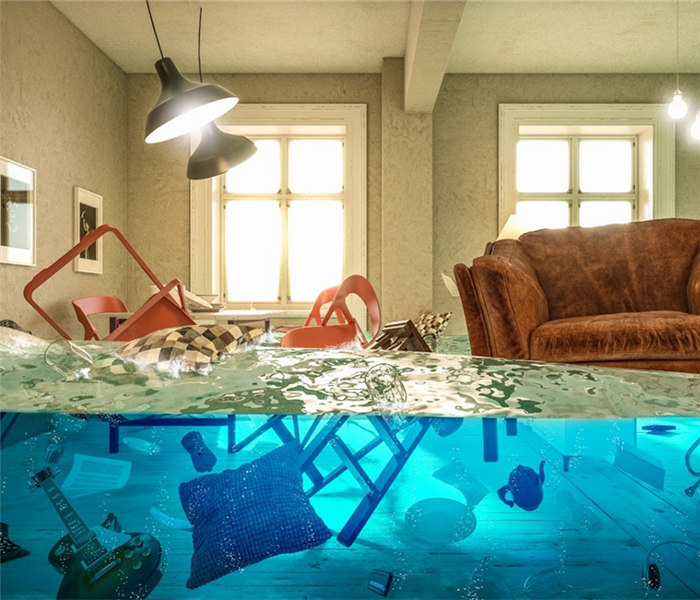 Floodwater can remain in your home even after you think it's gone. Contact SERVPRO for professional remediation and mitigation services in your home.
Floodwater can remain in your home even after you think it's gone. Contact SERVPRO for professional remediation and mitigation services in your home.
If Your Point Pleasant Beach Home Requires Flood Damage Remediation, Call SERVPRO Today!
Now that fall is around the corner, and hurricane season is imminent, it is essential to consider that your Point Pleasant Beach home could face flood damage. Any home adjacent to the Atlantic Ocean could be at risk of flooding. We do not say this to encourage you to live your life in fear of something that could happen. We say this to enable you to do what you can to prepare, should an emergency occur.
You may wonder what you can do to prepare your Point Pleasant Beach home for flood damage. The truth is, you cannot predict if your home might flood or how bad the water damage may be. Instead, it is essential to do your best to enable immediate access to your property for restoration professionals, like SERVPRO.
How Can I Help SERVPRO Get to the Damage on My Property ASAP?
There are a few things you can do for your home to help professionals get immediate access in the case of an emergency, including:
- Creating a SERVPRO READY Emergency Profile Plan
- Keeping a list of emergency phone numbers in an easily accessible place
- Telling professionals about any obstructions that may be between them and your home right away
A SERVPRO READY Emergency Profile Plan is free to create and allows us to make a map of your home to follow during an emergency. It is crucial to book an appointment with our technicians before the damage occurs for the plan to work. Furthermore, telling our professionals about obstructions, such as fallen trees, can ensure we are prepared before arriving.
How Can SERVPRO Remove Flood Water From My Home?
SERVPRO uses advanced technology to reduce standing water inside of your home. We can employ devices such as:
- Portable sump pumps
- Wet/dry vacuums
- Extractors
Should you have significant standing water on your property, we can use truck-mounted devices for water removal.
If you ever find your home in need of flood damage remediation, get help today. Contact SERVPRO of Point Pleasant by phoning (732) 202-3001. We are flood damage experts.
Click here for more information about Point Pleasant Beach.
Can Hardwood Floors Be Saved After Storm Damage?
7/31/2020 (Permalink)
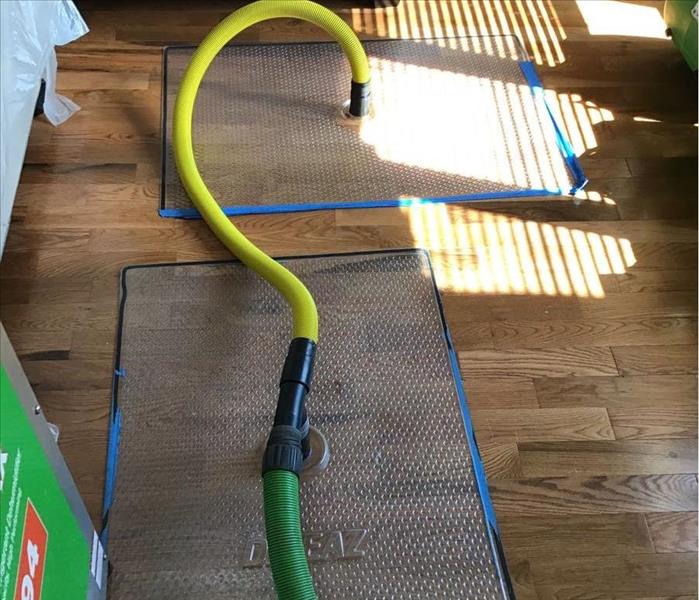 One step that may be used during the drying process are these water extraction mats as shown in this living room in Brick, NJ.
One step that may be used during the drying process are these water extraction mats as shown in this living room in Brick, NJ.
When a storm brings water into your home, SERVPRO of Point Pleasant will on site quickly to begin the drying process. When water saturates hardwood flooring, the fibers swell, and permanent damage occur. The sooner the water cleanup begins means the chances of saving your hardwood floors are greater.
SERVPRO has specialty equipment that may be able to save those hardwood floors. One step that may be used during the drying process are water extraction mats. These mats are very effective and efficient way to extract water moisture and vapor from hardwood floors. Extraction mats are placed in specific spots on the hardwood floors that pulls out remaining water and moisture that is in and under the floors.
We have highly trained technicians along with professional equipment to make your storm damage "Like it never even happened."
Call 732-349-9898 today for all your storm damage needs.
A Heavy Storm Caused Flood Damage in My Home. What Can I Do to Restore the Damaged Areas?
7/8/2020 (Permalink)
 Do you know the storm damage restoration process? Regardless give the certified technicians of SERVPRO of Point Pleasant to handle the issue.
Do you know the storm damage restoration process? Regardless give the certified technicians of SERVPRO of Point Pleasant to handle the issue.
Hire a Restoration Firm to Conduct Storm Flood Cleanup and Mitigation in Your Point Pleasant Beach Property
Floodwater can cause significant damage to your property that can lead to costly repairs. Act fast by contacting professional restorers from SERVPRO to prevent further damage in your Point Pleasant Beach home. We have gone through thorough training and have access to state-of-the-art equipment that helps us handle flood damage to make it “Like it never even happened.”
How fast can you start the restoration process?
Since we understand how stressful a flooding situation can turn out, we can dispatch a team of technicians to perform stormwater removal and cleanup in your Point Pleasant Beach property within a few hours. We inspect the property to determine the best restoration techniques and products to use. Our certified technicians use approved methods to ensure effective rehabilitation.
What destruction does floodwater cause?
When floodwater gets into your property, it can infect everything it touches because it usually contains harmful microorganisms. Murky water can conceal insects and even life-threatening wildlife. The pooling floodwater can cause long-term damage to items such as:
- Drywall and wallboard - These materials are porous, and when they absorb water, they may become weak and remain contaminated even after drying.
- Floor coverings - Laminated covers with foam rubber backing, can be destroyed beyond repair. Carpets that come into contact with contaminated water need to be replaced.
- Electrical wiring and pipes - Flooding can cause pipes to break. It can also ruin electrical wiring, leading to electrocution hazards.
- Laminated wood and particle board: These materials can swell, separate, and weaken after getting wet, typically not salvageable.
Which restoration services do professionals offer?
Since floodwater poses health risks to humans, it is essential to let SERVPRO professionals conduct the restoration process. Before we start removing the contaminated water, we wear protective gear such as face masks, full bodysuits, rubber boots, and chemical resistant gloves. Our flood damage restoration services include:
- Floodwater extraction - We can use self-priming trash pumps to extract the floodwater. We classify the pumps as slurry, full trash, or semi trash. The classifications are mainly based on the size of solids they can pass. Semi-trash pumps can pass solids less than 5/8” while trash pumps pass solids up to 1¼″. Full trash pumps can pass solids over 3”, and slurry pumps can carry fluid containing mud or sand.
- Drying – Our team performs thorough drying using centrifugal air movers and dehumidifiers. The equipment can remove moisture even in confined spaces. We can dry the contents of your home off-site or on-site.
- Removing and disposing of non-salvageable items.
- Eliminating odors in the property by using different deodorizing products and equipment
Do not let flood damage distort your daily activities. Contact SERVPRO of Point Pleasant at (732) 202-3001 for effective restoration. We’re Faster To Any Size Disaster.
Is It Possible to Completely Eliminate Bad Smells Associated with Flood Damage?
5/28/2020 (Permalink)
 After the flood, odors remain. SERVPRO has the know-how and tools to restore your home to its preloss condition.
After the flood, odors remain. SERVPRO has the know-how and tools to restore your home to its preloss condition.
Although It May Seem Unlikely at Times, Flood Damage Remediation Companies can Eliminate Unwanted Flood Damage-Related Smells.
In late October 2012, Hurricane Sandy made landfall just to the south of Point Pleasant Beach. While the storm itself was bad enough, its flooding effects were substantially enhanced because the moon was full at the time. As a result, the storm surge caused by the hurricane was as much as 20% worse than otherwise. Many area homeowners suddenly faced feet of floodwaters in their homes. In particular, one resident suffered a submerged basement and feet of standing water on the first floor of his home. He had a local flood damage cleanup and restoration company remove the water and clean up the mess but, months later, unpleasant smells still lingered in the Point Pleasant home. Fortunately, another local remediation service, SERVPRO, was able to eliminate the lingering unwanted smells.
What Causes Odors Associated with Floodwaters?
Experts classify floodwaters as “black water,” or water contaminated with human feces, dangerous chemicals, or medical waste. Therefore, flood damage in Point Pleasant Beach requires professional water removal and restoration services, which is because disease-causing microbes, like viruses, bacteria, and fungi, pollutes blackwater. It may even contain harmful parasites like tapeworms, which live in the intestines of humans. Odors arising from flooding events generally originate from one or more of the following sources:
- Trash washed away by floodwaters
- Sewage picked up by stormwaters flowing through sewers
- Microbial waste from microorganisms living in moisture-saturated materials
- Dead bodies of animals and humans that have been swept away by raging waters
- Soils with organic materials that microbes feed on
The longer these odor sources remain in your home, the worse smells become because odor-causing microbes proliferate over time.
Another essential thing to note is that poorly remediated flood damage can result in recurring smells months after restoration efforts have ceased. These odors are a result of workers failing to clean and treat surfaces with appropriate agents effectively, causing microbes to remain. While the initial treatment reduces the number of microorganisms present in your home and makes smells undetectable, these microbes are still around. Their colonies can rebound in the future under the right conditions. Since these microscopic creatures are moisture-loving, preferring a relative humidity above 59%, and thrive in warm temperatures exceeding 68F, their numbers increase in the hotter, more humid summer months. These conditions can cause previously remediated odors to return.
How Does SERVPRO Eliminate Odors?
To eliminate unpleasant odors, SERVPRO technicians first locate and remove their source. Our experts in Point Pleasant Beach remove the source by disposing of affected debris and killing odor-producing microbes. When getting rid of these offending microorganisms, we do one or more of the following: treat impacted materials with chemical agents, cut-off microbe food sources, reduce interior relative humidity to below 60%, and keep temperatures below 68F for an extended period. When treating your home, we use a wide variety of chemical agents to neutralize odors. These include:
- Disinfectants and antifungals to hinder the growth of bacteria and fungi
- Pairing agents that combine with airborne odor particles, forcing them to fall onto surfaces and making them easier to clean up
- Absorption agents to absorb moisture and reduce humidity
- Masking chemicals that cover unpleasant odors with pleasing smells
While these products are highly effective in odor remediation, we also make sure residents like their smell. Their approval is vital because we want the replacement smells to be more pleasant to the homeowner than those they replace.
There are several ways in which SERVPRO removes unwanted smells from your Point Pleasant Beach home. These include methods of drying, as well as ways of applying disinfectants, antifungals, and deodorants to affected surfaces and materials. Some of our methods are:
- Using high-velocity box fans to quickly ventilate your home, before and after we employ chemical agents
- Employing high-tech air scrubbers to remove odor-causing particles and chemicals from the air
- Wet fogging, where ultra-low volume foggers inject solvent-based deodorants and other agents into difficult-to-reach areas
- Directly spraying disinfectants onto affected surfaces
Most times, these tools and measures solve residents’ odor-related complaints. We can use them at the time flood damage occurs or later when issues arise.
Sometimes it may seem like certain unwanted smells are impossible to eliminate, but this is certainly not the case. If you ever experience an ongoing flood-related odor issue, remember some companies can help you. They can solve your problem, just like SERVPRO helped the Point Pleasant Beach resident suffering the lingering malodorous effects of Hurricane Sandy.
If you ever need assistance dealing with unwanted smells from prior flooding, contact SERVPRO of Point Pleasant at (732) 202-3001.
Avoid Electrical Hazards after a Hurricane or Flood
7/30/2019 (Permalink)
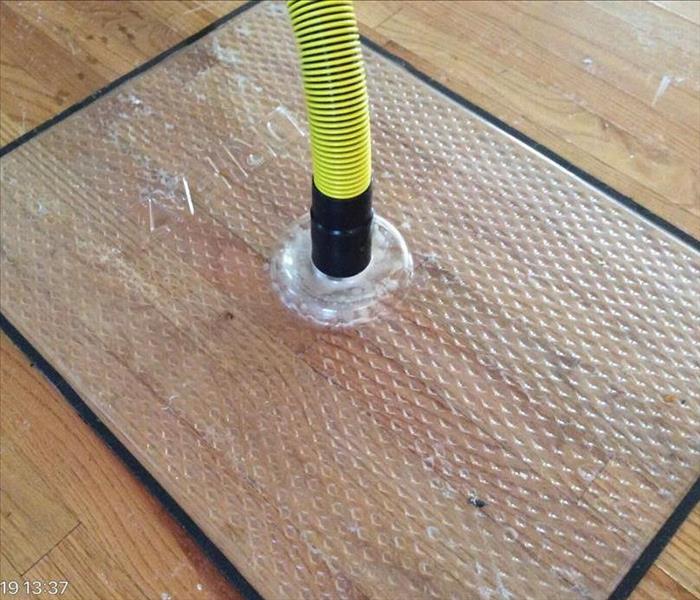 This is just one step in the water extraction process that SERVPRO of Point Pleasant preforms to make it "Like it never even happened."
This is just one step in the water extraction process that SERVPRO of Point Pleasant preforms to make it "Like it never even happened."
After a hurricane, flood or other natural disaster you need to be careful to avoid electrical hazards both in your home and elsewhere. The Center for Disease Control and Prevention recommends these tips to stay safe from electrical hazards:
- Never touch a fallen power line. Always the power company to report fallen power lines.
- Avoid contact with overhead power lines during cleanup and other activities.
- Do not drive through standing water if downed power lines are in the water.
- If a power line falls across your car while you are driving, stay inside the vehicle and continue to drive away from the line. If the engine stalls, do not turn off the ignition. Warn people not to touch the car or the line. Call or ask someone to call the local utility company and emergency services. Do not allow anyone other than emergency personnel to approach your vehicle.
- If electrical circuits and electrical equipment have gotten wet or are in or near water, turn off the power at the main breaker or fuse on the service panel. Do not enter standing water to access the main power switch. Call an electrician to turn it off.
- Never turn power on or off yourself or use an electric tool or appliance while standing in water. Do not turn the power back on until electrical equipment has been inspected by a qualified electrician. All electrical equipment and appliances must be completely dry before returning them to service. Have a certified electrician check these items if there is any question.
- If you see frayed wiring or sparks when you restore power, or if there is an odor of something burning but no visible fire, you should immediately shut off the electrical system at the main circuit breaker.
- Consult your utility company about using electrical equipment, including power generators. Do not connect generators to your home’s electrical circuits without the approved, automatic-interrupt devices. If a generator is on line when electrical service is restored, it can become a major fire hazard and it may endanger line workers helping to restore power in your area.
Take the necessary steps to protect yourself and your loved ones after a hurricane, storm or flood.
If you believe someone has had an electrical shock, do not touch them, call 911 immediately.
After your New Jersey property is safe from all electrical hazards, call SERVPRO of Point Pleasant to begin the water damage cleanup and restoration. For more information on water and storm damage cleanup, call us 24/7 at 732-202-3001.
Flood Damage Prevention Tips
5/15/2019 (Permalink)
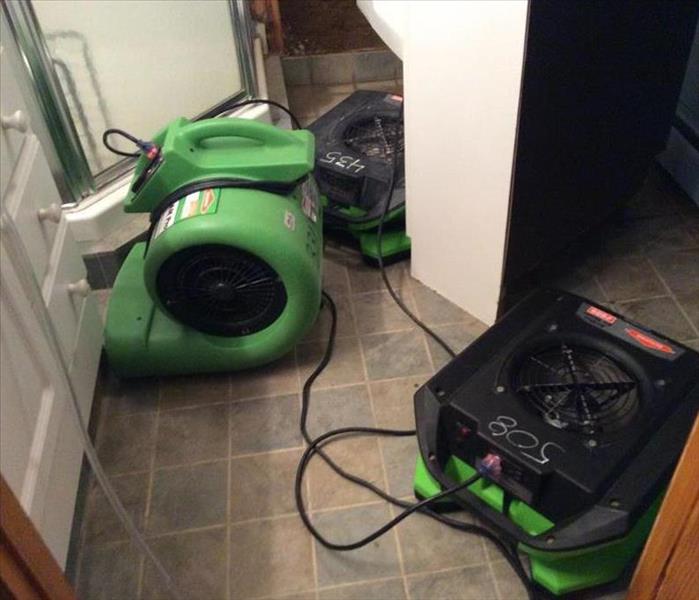 Ocean County suffered heavy rain in August 2018 that resulted in flooding. Brick was one of the areas largely affected with major water damage.
Ocean County suffered heavy rain in August 2018 that resulted in flooding. Brick was one of the areas largely affected with major water damage.
Floods rank as one of the most common and widespread natural disasters in the United States. Whether you live near the Jersey coastline, along city streets or near a river or lake, there is always a potential for suffering flood damage. On average, floods cost $6 billion in annual losses in the U.S. Flooding can also result from plumbing failures, frozen pipes and damaged structures. Flood damage can affect your business operation in a variety of ways and can range in size from being isolated to a single room to entire floors being fully submerged.
Knowing how to prepare and deal with potential flooding in advance can affect how much of your property can be restored and how much has to be replaced. Below are prevention, mitigation and restoration tips to follow until help arrives:
Flood Prevention Tips:
- Determine if your property is in a floodplain.
- In any emergency, always listen to the instructions given by local emergency management officials.
- Carefully assess how your company functions, both internally and externally, to determine which staff, materials, procedures and equipment are absolutely necessary to keep the business operating.
- Plan what you will do if your building, plant or store is not accessible. This type of planning is often referred to as a continuity of operations plan, or COOP, and includes all facets of your business.
- Plan for payroll continuity.
- Review your emergency plans annually. Just as your business changes over time, so do your preparedness needs. When you hire new employees or when there are changes in how your company functions, you should update your plans and inform your people.
- Visit Ready.gov for a comprehensive plan and to learn about emergency plans for New Jersey.
Flood damage affect not only the structure of your property but also your belongings. SERVPRO of Point Pleasant understands that your home is more than a structure; your family’s furniture, clothing, keepsakes, and other belongings help transform a house into a home. The first 24 hours after flooding are the most important in preventing secondary or permanent damage. Our team is ready to respond as quickly as possible to help our Ocean County community with water cleanup and restoration.
Be Prepared for Hurricane Season 2018
6/1/2018 (Permalink)
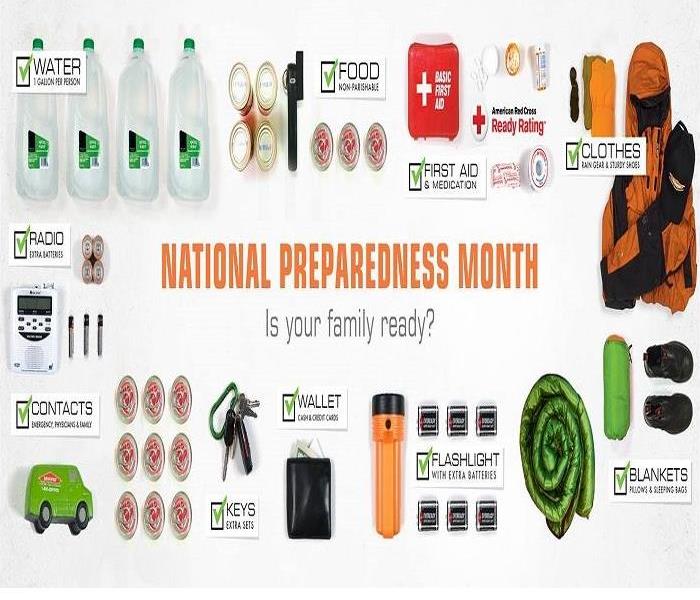 With the start of the Atlantic hurricane season here, now is the time to prepare at the Jersey Shore.
With the start of the Atlantic hurricane season here, now is the time to prepare at the Jersey Shore.
Be Prepared Before a Hurricane Strikes
Living at the Jersey Shore makes us prone to severe weather disasters including hurricanes and tropical storms that may bring coastal flooding. While predicting exactly how much damage a storm will cause is impossible, with some preventive measures, you and your family can try to minimize the potential damage. Here are three things you can do to prepare for flooding from a powerful hurricane or tropical storm:
- Create a Disaster Survival Kit
In case of an emergency you should always have a disaster survival kit that you and your family update every so often. Include items like bottled water, non-perishable food, flashlights, batteries (for radios, flashlights), and a first aid medical kit. Shop early for supplies. Essential items usually sell out fast before a storm. Remember to write down important emergency contact information and insurance documents, as well as essential medications and lastly, do not forget cell phone chargers, either. - Secure Your Home & Valuables
Before the storm arrives, if possible, move or secure any items that are in danger of causing damage or becoming destroyed by strong winds, such as outdoor furniture. Inside the home, you can move furniture, valuables, hazardous materials, and important documents to higher ground inside your home. For safety, remember to shut off the main power supply to your home, as well as unplug all electronics. If you, a loved one or a neighbor have a mobile home, ensure it is properly secured and anchored. - Help Others in Need of Assistance and Protect Pets
In addition to protecting you and your family make sure to help anyone in need of assistance. Before the storm hits, ask them if they need any assistance evacuating or preparing before the storm. Do not forget about pets. If necessary, make special arrangements for safe transport of your pets while remembering to bring any pet medications and enough food to last through the ordeal. If you need a safe place for your pet during the disaster, contact your local animal shelter. Never leave them behind.
We all know flooding is part of living near the water. Here at SERVPRO of Point Pleasant, we are prepared 24 hours a day to cleanup and dry your water damaged property, if you do suffer flooding. We can start the remediation process immediately after you contact us. A faster response lessens the mold damage, limits additional damage, and reduces the remediation cost. We have the experience and advanced training that enables us to restore your property quickly.
Contact us 24/7 at 732-202-3001 for all your storm related damage.
SERVPRO of Point Pleasant is Ready for Whatever Happens. Are you?
4/3/2018 (Permalink)
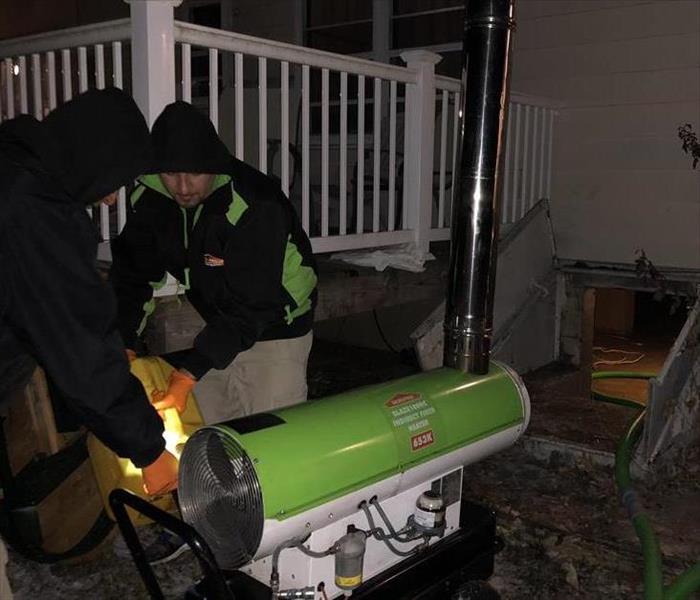 SERVPR of Point Pleasant is there when you need them, 24 hours a day, 7 days a week, 365 days a year.
SERVPR of Point Pleasant is there when you need them, 24 hours a day, 7 days a week, 365 days a year.
When a storm or disaster strikes, SERVPRO of Point Pleasant is prepared and ready to take action and you should be too. Be prepared in your home or business with an Emergency Kit. Ready.gov suggests you to have enough supplies to last for at least three days. Below are some suggested items to include in your kit:
- 3 day supply of nonperishable foods
- Water (One+ gallon per person)
- First Aid Kit
- Prescription Medicine
- Sleeping Bag or blankets
- Fire extinguisher
- Hygiene products
- Flashlights
- Extra batteries
- Cell phone charger
- Change of clothes
- Matches in waterproof container
- Wrench or pliers to turn off utilities
- Whistle to signal for help
- Pet supplies
- Infant formula and diapers
- Important documents such as insurance policies, ID’s, and bank records in a plastic container
For a more extensive list, check out Ready.gov.
Whenever or whatever the disaster SERVPRO of Point Pleasant is there when you need them.
Faster to Any Size Flood Disaster
3/21/2018 (Permalink)
 Brave New World experienced flood damage and they called the cleanup team that is faster is any size disaster.
Brave New World experienced flood damage and they called the cleanup team that is faster is any size disaster.
Having a home or business by the Jersey Shore, there is always a potential for flood damage. Floods are one of the most common and widespread natural disasters in the United States. Just because you have not experienced a flood in the past does not mean you will not in the future. Nearly 20% of all flood insurance claims come from moderate to low risk areas.
When flood damage puts the things that matter most on the line, you need the very best help on the line as well. That is why contacting SERVPRO of Point Pleasant as soon as possible is so important. Even minor floods have the potential to cause major damage to a structure when not treated quickly and properly. Call us at 732-202-3001 or visit our storm and flood damage cleanup and restoration page for more information on our services. Our company is a leader in giving control back to home and business owners and even entire communities after the ravaging effects of water.
New Jersey's "Bomb Cyclone"
1/8/2018 (Permalink)
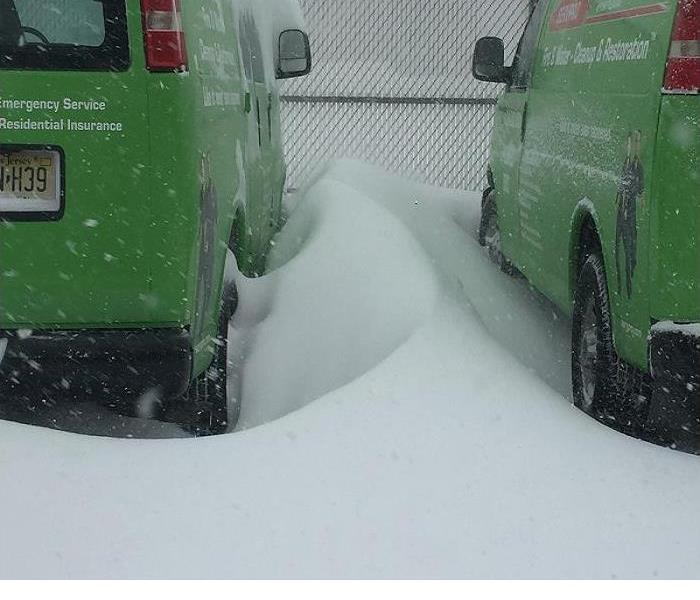 SERVPRO of Point Pleasant's fleet of trucks during the 2018 "bomb cyclone".
SERVPRO of Point Pleasant's fleet of trucks during the 2018 "bomb cyclone".
A winter hurricane called a “bomb cyclone” is about to cause problems for New Jersey and all along the East Coast. According to the Toms River Patch, a “bomb cyclone” is a meteorological term and described as such because its pressure is predicted to fall so fast, an indicator of explosive strengthening of the storm.
This “bomb cyclone” will be on the way here after forming off the coast of Florida on Wednesday, Jan 2, 2018. This winter storm is expected to hit New England with strong winds exceeding 45 miles per hour and blizzard conditions on Thursday. Luckily, the worst of the storm will hover 20 to 50 miles, or more, off the Jersey Shore. Worst case scenario is if the storm tracks closer to the coast, then some sections of New Jersey could get hit with as much as 8 to 12 inches of snow.
The temperatures will dip into the polar vortex range, which can cause your pipes to freeze and ice damns that can cause series damage to your home. The term “Polar Vortex” is used when referring to the frigidly cold temperatures we experience during the winter months in many regions of the United States. Thursday night, gusty winds coupled with temperatures that will drop into the single digits and low teens will freeze the Garden State deeper with sub-zero wind chills. Well below freezing temperatures are expected to linger through Friday and Saturday.
In the event of a burst pipe or ice damn damage, call SERVPRO of Point Pleasant at 732-202-3001 for all your storm damage cleanup.
Be Hurricane Ready
9/7/2017 (Permalink)
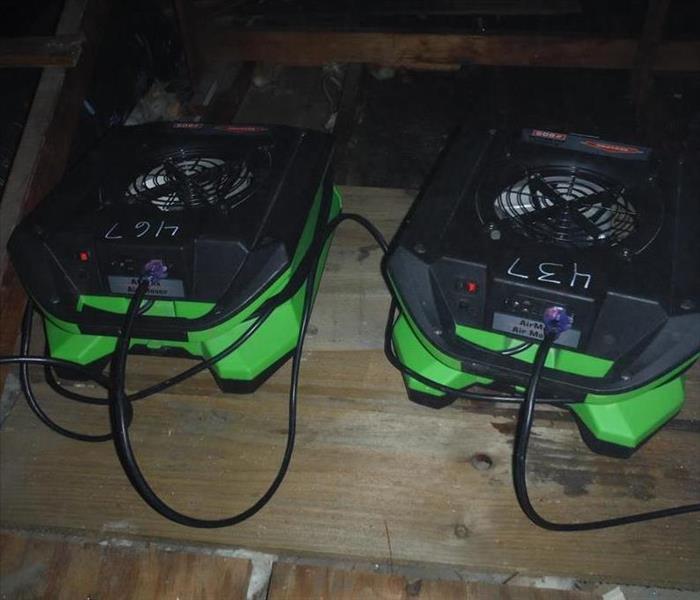 Water damage in this Ortley Beach residence being dried to prevent further damage.
Water damage in this Ortley Beach residence being dried to prevent further damage.
After Hurricane Harvey hit Texas and as Hurricane Irma quickly approaches Florida as a category 5, it reminds the rest of us that we should always plan ahead. Preparation is key to making it through any size disaster. SERVPRO of Point Pleasant offers these simple steps to plan ahead:
- Check your insurance policy to see what is covered and make sure to purchase flood insurance if you do not already have it.
- Review your area’s evacuation plans so in the event of a quick evacuation you will know where to go.
- Make sure your residence is hurricane ready by checking for existing damage and fixing whatever needs to be fixed.
- Purchase supplies and have them organized together in case you need to evacuate or in case you are without power for some time. Please use the American Red Cross Checklist for a list supplies you will need.
- Make copies of all your important documents and store them in a dry, safe place.
- Take pictures of your residence and belongings and keep them in a dry, safe place.
After a hurricane, we are dedicated to responding immediately to your water and storm damage emergency. Our highly trained professionals use specialized equipment and advanced training to quickly restore your Toms River property to pre-storm condition. Major storms and flooding events can overwhelm many restoration companies. On the other hand, SERVPRO of Point Pleasant can access resources from 1,700 Franchises across the state and country and even utilize Disaster Recovery Teams for major storms and disasters.
To help those impacted by Hurricane Harvey, please donate to the American Red Cross.
Hurricane Preparedness Week is May 7-13, 2017.
4/27/2017 (Permalink)
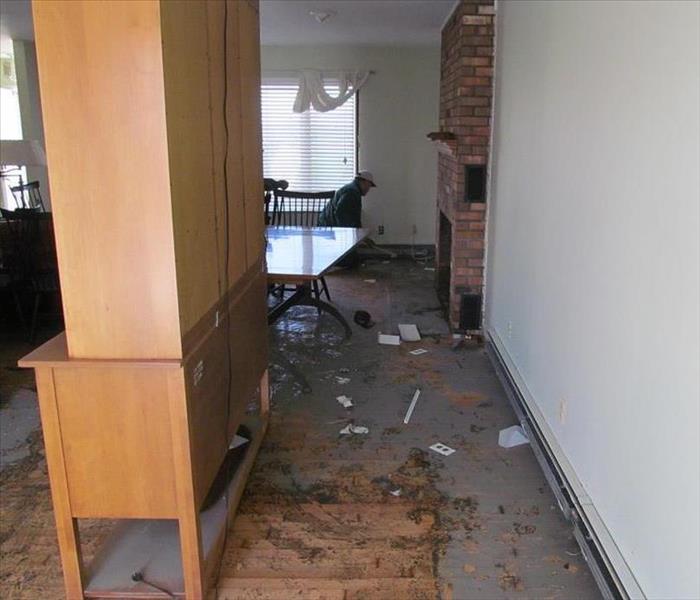 SERVPRO of Point Pleasant cleaning up storm damage from Hurricane Sandy,
SERVPRO of Point Pleasant cleaning up storm damage from Hurricane Sandy,
Hurricane Preparedness Week is May 7-13, 2017.
Hurricane season in New Jersey is June 1st through November 30th and since it can only take one storm to change your life, it pays to be prepared. Planning ahead for a major disaster may help to minimize damage to yourself, loved ones, pets, home and belongings.
The goal of Hurricane Preparedness Week is to inform people about hurricane hazards and provide knowledge that can be used if one occurs. If you haven’t done so in the past, there is no better time than hurricane preparedness week to begin.
Every day during Hurricane Preparedness Week will focus on a specific topic:
- Sunday May 7th Determine Your Risk
- Monday May 8th Develop an Evacuation Plan
- Tuesday May 9th Assemble Disaster Supplies
- Wednesday May 10th Secure an Insurance Checkup
- Thursday May 11th Strengthen Your Home
- Friday May 12th Check on Your Neighbors
- Saturday May 13th Complete Your Written Hurricane Plan
Please visit The National Weather Service for more information on these specific topics.
The American Red Cross offers a Hurricane Safety Checklist and FEMA offers a guide on How to Prepare for a Hurricane.
In the event of storm damage after a hurricane, call SERVPRO of Point Pleasant at 732-202-3001.
After a Flood
2/14/2017 (Permalink)
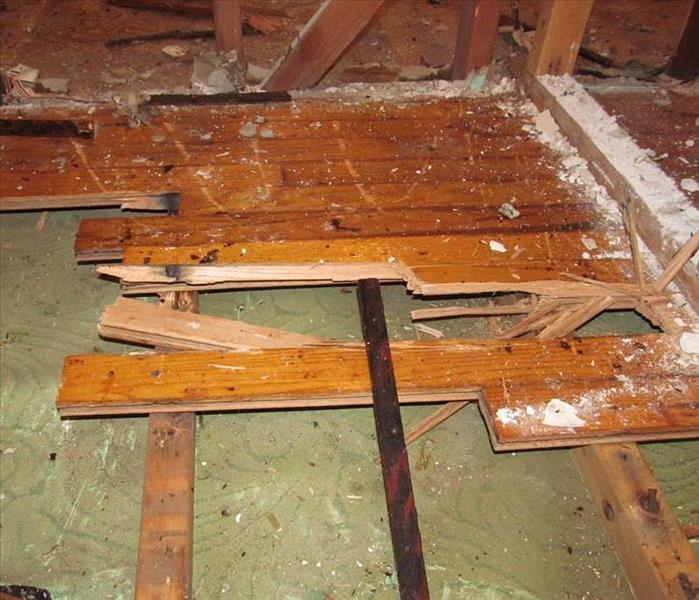 SERVPRO of Point Pleasant is in the process of restoring this flooded home in Ocean County to it's pre-storm condition.
SERVPRO of Point Pleasant is in the process of restoring this flooded home in Ocean County to it's pre-storm condition.
After a Flood
After a flood mold can spread quickly through your Ocean County home or business in as little as 48 hours. Water damaged areas and items should be dried within 24-48 hours to prevent mold growth. If you were unable to properly dry your belongings and control the moisture within this time period, you should assume that you have mold growth. Just because you cannot see it does not mean that it is not present. It may be hidden under or behind items like carpet, cushions, or walls. Flood waters may also have carried sewage or chemicals into your home. This could expose you or your family to viruses, bacteria, disease carriers (such as mosquitoes), and parasites, as well as mold.
Cleaning up yourself after a flood can pose certain health risks to you and your family. Before you start the cleanup process ask yourself if it is too dangerous or difficult to do yourself. If you are unsure it may be best to get help from experienced and qualified professionals. As leaders in the water damage and mold remediation industry, SERVPRO of Point Pleasant has advanced training and expertise, not to mention a tremendous amount of hands-on experience. We use this training and experience to quickly dry your home and restore it back to pre-storm condition.
Restoring flood-damaged properties is the cornerstone of our business. Our highly trained professionals use specialized equipment and advanced training to quickly restore your Point Pleasant or Brick property to pre-flooding condition. We’re dedicated to responding immediately, which helps to minimize secondary damage.
Have Flood or Mold Damage?
Call Us Today 732-202-3001
Storm Damage Cleanup and Restoration in Point Pleasant, NJ
1/27/2017 (Permalink)
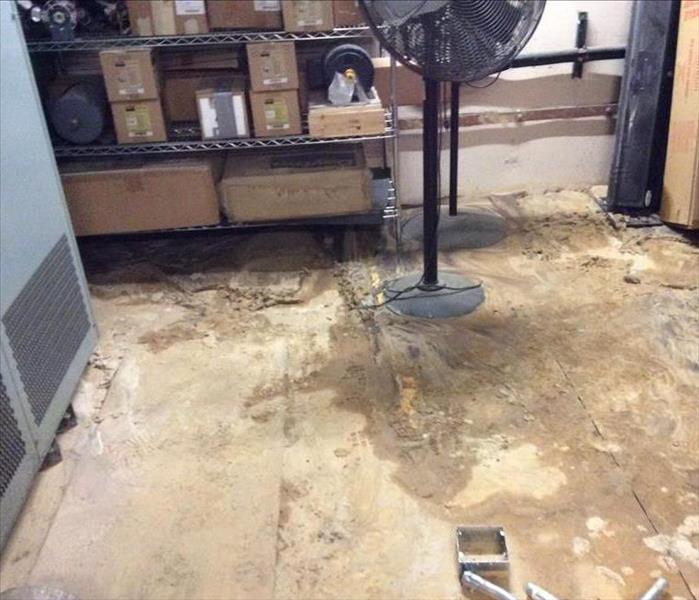 A winter storm brought water and sand into this commercial building in Lakewood, NJ. SERVPRO of Point Pleasant was there to cleanup the storm damage.
A winter storm brought water and sand into this commercial building in Lakewood, NJ. SERVPRO of Point Pleasant was there to cleanup the storm damage.
Storm Damage Cleanup and Restoration in Point Pleasant, NJ
Storm and flood damage should be attended to quickly after the storm has passed in order to reduce costs and minimize secondary damage. SERVPRO of Point Pleasant is one of the most trusted storm damage cleanup and restoration companies serving Point Pleasant, NJ and nearby towns. If your home or business is damaged by a hurricane, tornado, blizzard or flood, we can help aid your recovery efforts.
Beautiful but Vulnerable Communities
The coastal lifestyle is enviable, but it’s not without its risks. In 2012, Hurricane Sandy had a devastating impact on New Jersey, particularly in Point Pleasant.
While Hurricane Sandy was considered a once-in-a-lifetime storm, it reminded us of Mother Nature’s unpredictability. Atlantic hurricane season is an annual threat to NJ, as are powerful winter storms that can cause significant damage of their own.
Storm Damage Repair Experts
Storm damage and restoration is one of our main areas of expertise here at SERVPRO of Point Pleasant. Our storm and flood services include:
- Disaster Response and Recovery
- Water Damage Restoration
- Contents Restoration
- Move-Outs (if needed)
- Mold Remediation
- Sewage Cleanup
- Carpet Cleaning
- Odor Removal
- Building Services
- Commercial Storm Damage Repair
- Commercial Large Loss Recovery
Why SERVPRO of Point Pleasant?
A storm can strike at any time. That’s why SERVPRO of Point Pleasant is available 24/7 to provide:
- Immediate Response
- Highly Trained and Experienced Professionals
- Specialized Equipment
- Assistance with Any Disaster of Any Magnitude
- Emphasis on Restoring Over Replacing
- Personalized, Local Care Backed by a Nationally Trusted Name
SERVPRO of Point Pleasant stands ready to mobilize in the towns of Point Pleasant, Point Pleasant Beach, Bay Head, Lakewood, Point Pleasant Boro and Brick. For any of your storm damage cleanup and restoration needs, call us at 732-202-3001.
 Hurricane Preparedness Month emphasizes the importance of planning, securing your home, and assembling emergency supplies to stay safe.
Hurricane Preparedness Month emphasizes the importance of planning, securing your home, and assembling emergency supplies to stay safe.





 24/7 Emergency Service
24/7 Emergency Service
























